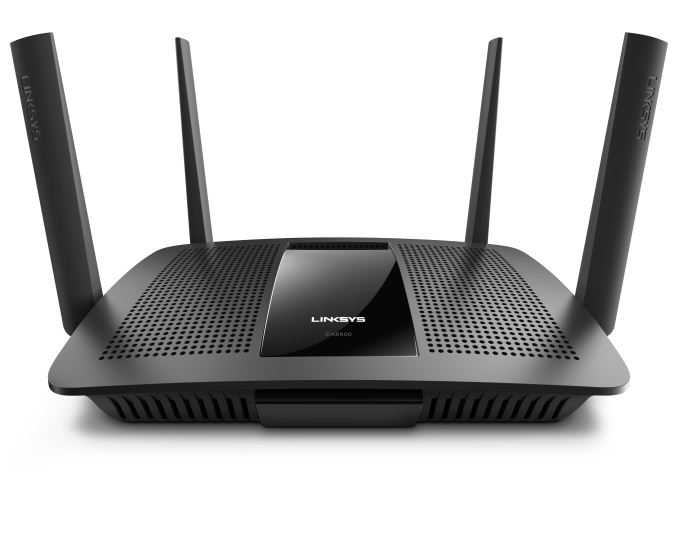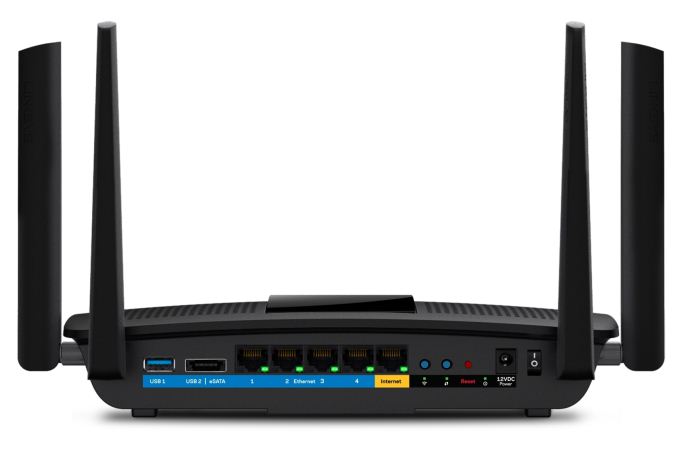Linksys EA8500 - First MU-MIMO Enabled 802.11ac Router Set to Ship
by Ganesh T S on May 7, 2015 7:00 AM EST- Posted in
- Networking
- Linksys
- 802.11ac
- Wi-Fi
- Qualcomm Atheros

Readers following our wireless networking coverage must be quite familiar with the developments in 802.11ac land. As a recap:
- The first 3-stream 802.11ac routers (based on the Broadcom BCM4706 chipset) started shipping in May 2012, with Buffalo Technologies and Netgear leading the way. There were marketed as AC1750 units (3x3 5 GHz providing up to 1300 Mbps and 3x3 2.4 GHz providing up to 450 Mbps). The street pricing of the AC1750 routers started to go down once Qualcomm started shipping their first-generation 802.11ac router platforms in products such as the TP-LINK Archer C7 in April 2013.
- In Q4 2013, a wave of AC1900 units started to hit the market. Netgear's Nighthawk R7000, a popular member in this series, still continues to sell well in the market. These units still used a 3x3 5 GHz radio for up to 1300 Mbps, but the 2.4 GHz had some proprietary Broadcom extensions (TurboQAM) to support up to 600 Mbps in an end-to-end Broadcom environment.
- In 2014, Quantenna began to bring their technology lead in the Wi-Fi space to the market with their Wave 2 4x4 802.11ac chipset. Despite being announced at CES 2014, the Asus RT-AC87U began to ship in July with the QSR1000 radio coupled with a Broadcom SoC. Netgear started to ship the same radio coupled with a Qualcomm IPQ8064 SoC in the Nighthawk X4 in September 2014. The QSR1000's Wave 2 feature set includes support for MU-MIMO, but neither of these routers shipped with MU-MIMO enabled in the firmware (citing lack of client support at that point of time). Given the 4x4 configuration, these routers were tagged as AC2350 / AC2400 units (600 Mbps in the 2.4 GHz band and 1733 Mbps in the 5 GHz band)
- In the midst of these Wave 2 product launches, Qualcomm announced plans for their Wave 2 802.11ac platforms (both routers and clients) in April 2014. Broadcom, being late to the Wave 2 party, decided to bring out the XStream platform with dual 5 GHz radios (six-stream configuration) also in April. They were able to get it quickly into the market too, with the Netgear Nighthawk X6 R8000 becoming available in June 2014.
- At CES 2015, we saw the first set of routers based on Qualcomm's QCA9880 4x4 Wave 2 802.11ac router platform getting announced. Vendors such as TP-LINK and TRENDnet were expecting their AC2600 class routers to ship towards the middle of the year.
Coming back to today's announcement regarding the EA8500, Linksys is becoming the first vendor to start shipping a QCA9980-based router. The important aspect here is that the router will ship with MU-MIMO enabled. Client devices with MU-MIMO enabled are also coming into the market just now (more on that in our detailed review). Hopefully, this announcement will spur both Netgear and Asus to enable MU-MIMO in the firmware for their Quantenna-based routers.
The salient features of the EA8500 router are listed below:
- 4x4 802.11ac with MU-MIMO and beamforming support
- QCA9980 radio + 1.4 GHz dual-core IPQ8064 SoC
- Simultaneous dual-band operation (5 GHz 802.11ac - 1733 Mbps, 5 GHz 802.11n - 600 Mbps, 2.4 GHz 802.11n - 800 Mbps)
- 1x USB 3.0, 1x USB 2.0 / eSATA
- 4x 1Gbps LAN, 1x 1Gbps WAN
- Adjustable antennas for optimal performance
One important point to note is that MU-MIMO capabilities will translate into real benefit only when there are multiple MU-MIMO-capable client devices talking to the router simultaneously. This will probably be a common scenario in enterprise Wi-Fi deployments soon. However, in a typical household, we would imagine that a situation involving multiple MU-MIMO clients is probably at least a good year away. Qualcomm is targeting an end-to-end play here, as the announcement made last year included a number of products in the client space with MU-MIMO capabilities.
Linksys is accepting pre-orders at $280 for the EA8500 today with shipments slated for May 10, 2015. Wide retail and e-tail availability is also expected starting next week. There is no doubt that MU-MIMO will be the most efficient way to boost Wi-Fi performance in the near future, and it is good that Linksys and Qualcomm are teaming together to accelerate its market adoption.
Source: Linksys











83 Comments
View All Comments
Kutark - Thursday, May 7, 2015 - link
I really hate wifi, a lot. Ive always bought high end routers, dont tons of research, and its still not even close to approaching how good a basic 100basetx switch was 10 years ago. Its definitely gotten better, but it seems like we're still 3-5 years from wifi being able to seriously supplant a wired setup.I honestly wish building codes would be updated to make them put ethernet in every room in a house. It would add very little to the cost of building a home and wired will always be superior to wireless. Not to mention the lack of security concerns.
bigboxes - Friday, May 8, 2015 - link
It's like you are still in the 20th century kicking and screaming as they drag you into the modern age. Look, I'm with you on the wired thing. You don't have to sell anyone on that here @ AT. The problem is that the desktop is not people's primary means of accessing the network any longer. It's laptops, tablets and phones. Like it or not it's these devices that the masses are using. They are not tied down to a desk. No, they are on the couch in the living room, laying on the floor in their bedroom, propped up on their kitchen counter or sitting outside in the backyard.I've got four of my computers hard-wired with Cat6 to my switch. However, we have two tablets and two smartphones. Throw in guests and their devices and it's a must to have a good wireless network. Now, do you hate wi-fi when you are at a business or do you insist that they uncoil some Cat5 from their spool?
hjmassey - Friday, May 8, 2015 - link
I'm with you, if it doesn't move - desktop computers, set-top boxes, etc. - I run a cable. But I've got tablets, smartphones, work laptop, that need WiFi. 11n works just fine for me. I have done a few large enterprise WiFi implementations using Aruba (a/b/g/n) gear and can see where ac will be useful in the enterprise (once MU-MIMO is working for most clients) but don't see a lot of advantage for home use unless you've got a media server dishing out multiple streams or have (and use) a 1Gbps or better pipe from your ISP.Kutark - Sunday, May 17, 2015 - link
You are misunderstanding me, i didnt say wifi is useless and everything should be wired. I simply stated wifi has a ways to go before it can be a serious alternative to wired for most situations.Absolutely in a commercial building where the spaces tend to be open it tends to work a lot better. But in a home environment its sketchy as hell. I can literally go from one from to another room 15 feet away and lose 60% of the signal. I've had people have connectivitiy issues sitting literally 10 feet away from our Ubiquiti (which has been great overall) because there are 15 thousand (slight exaggeration) other wifi networks on the same wavelength and it just makes things sketchy in a household. Again, this is anecdotal based off my own personal experience.
I was probably too harsh in saying i hate wifi. I dont hate it, i just hate that it seems like its 85% of the way there.
Kutark - Sunday, May 17, 2015 - link
I should also clarify the building code statements. IMO there is no reason they can't slap a pair of RJ45 ports next to one of the sockets in each room when they're building a house. Its really minor when they're building it because a couple lines of cat5e/6 would add maybe $500-1000 to the overall cost of a new home. And it makes life so much easier, you plug your desktops in, your HTPC's in. Hell if the ports arent behind a couch or something, you can plug your laptop in too, depending on what you plan on doing with it.In a public place like a starbucks, obviously wired is just plain stupid. Wifi IMO is best suited for those types of situations.
UtilityMax - Tuesday, May 12, 2015 - link
Indeed. The best I have seen with AC, is about 200-300Mbit transfer rate, but that's direct from client to the router. So that pipe width is shared by all clients, once you copy a file from one machine to another, you're effectively not much faster than a 100Mbit ethernet.. The MU-MIMO routers will fix some of that, since MU-MIMO will allow a four stream router to talk simultaneously to say two two-stream clients, but that's still years away since practically no hardware on the market supports MU-MIMO.Kutark - Sunday, May 17, 2015 - link
And i should have clarified also i was referring more to file transfers, not just watching youtube, or netflix or something like that on a tablet.But if i want to use wifi say to transfer some of my steam data that i already downloaded to my laptop, i might as well start building a ship in a bottle because ill be finished with that well before that 10gig game download transfers from my desktop to my laptop via wifi.
zodiacfml - Friday, May 8, 2015 - link
Having a lot of Wi-Fi problems with a school enabled with tablets, I learned a lot about the AC standard.If this quickly gets cheaper compared to a dual 5ghz radio, then I'm interested. Otherwise, a dual 5ghz Wi-Fi router is the way to go for multiple devices as the 5Ghz band is decently wide for such WiFI device. I haven't seen any device capable of 160 Mhz bandwidth. Using 80Mhz should allow two channels available in the band. You should have little problems with interference with other routers as the 5Ghz gets weak pretty easily with obstructions.
Yet, all these high-end devices are particularly useful if you have at least 9 or more devices in range.
UtilityMax - Tuesday, May 12, 2015 - link
There is absolutely no reason to get a MU-MIMO router right now, since clients do not support this technology yet. It will make sense 2-3 years down the road, and I hope the prices will drop by then.stun - Friday, May 8, 2015 - link
Can anyone please tell me the difference between Netgear X4, Netgear X6, Apple AirPort, and this Linksys EA8500 (apart from the MU-MIMO feature enabled)? Why would one pick X6 over X4 or vice versa? It is very difficult to understand what the differences between them are.